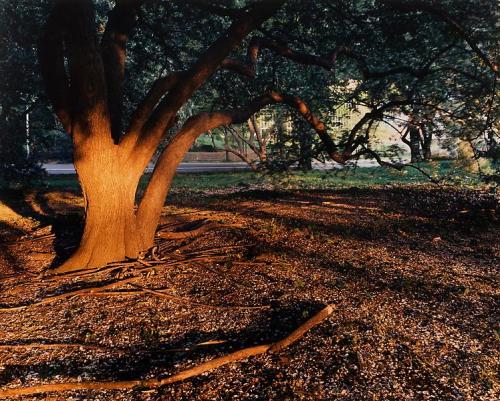
Central Park, north of the Obelisk, behind the Metropolitan Museum of Art, New York, May 1993
“Jennifer Levin and Robert Chambers were seen leaving Dorrian’s Red Hand, an Upper East Side bar, at 4:30 A.M. on August 26, 1986. Her body was found beneath this crab apple tree in Central Park at 6:15 A.M. that same morning. An autopsy revealed that she had been strangled. She was eighteen years old when she died. Chambers, who was nineteen at the same time of the crime, pleaded guilty to first-degree manslaughter.”
Joel Sternfeld - On This Site: Landscape In Memorium - Luhring Augustine
My project is about places where people have died in Bristol, and my tutor Nick recommended that I look at Joel Sternfeld’s work. I like this quote about it, from Photography, Memory and Tragedy: Joel Sternfeld’s On This Site by Linda Levitt on DocumentaryWorks.org
“Sternfeld describes his project as seeking out the “list of places [he] cannot forget because of the tragedies that identify them.” Many of these places, however, are not marked by the trace of catastrophic events. How can the photograph speak for the tragic, if the site itself cannot? What “truth” do these photographs tell? On This Site questions how much information a photograph can hold: the images and text show that Sternfeld knows that even in the here-and-now of standing in a particular place, he can only know, and can only re-present, what he sees. Yet we also know what we remember, and in this way revisiting a familiar place is always fraught with a powerful kind of confusion about how we tie meaning to place. Sternfeld creates a context for his photographs that simultaneously enables and demands these images to take on a particular function: recalling and recording the tragic.”
It’s these issues I’m struggling with. Obviously Stenfeld is a much better photographer than I am - I’m looking at these and thinking I can’t get close to these, so maybe I shouldn’t be trying - and I want to know everything about them, how he showed them, how they’re presented, how he combines the words and pictures in his ideal iteration of the project. The things he’s chosen to shoot range from places like this one to the seat Lee Harvey Oswald was sitting in when he was arrested, the office used by Dan White before he shot Harvey Milk, the Stonewall bar and more - a range of incidents over time and USA geography. Some more:
“Speaking at a rally on April 3, 1968, Dr. Martin Luther King, Jr., said:
Longevity has its place. But I’m not concerned about that now. I just want to do God’s will. And He’s allowed me to go up to the mountain. And I’ve looked over and I’ve seen the Promised Land. I may not get there with you. But I want you to know tonight that we, as a people, will get to the Promised Land. And I’m happy tonight. I’m not worried about anything. I’m not fearing any man. My eyes have seen the glory of the coming of the Lord.
The next day, he was assassinated on this balcony outside room 306.”
 The Northwest Corner of Florence and Normandie Avenues, Los Angeles, CA, October 1993
The Northwest Corner of Florence and Normandie Avenues, Los Angeles, CA, October 1993
“On April 29, 1992, four white police officers on trial for the beating of motorist Rodney King were acquitted. A videotape of King’s beating had been extensively televised. The not guilty verdicts became a catalyst for widespread civil unrest.
Riots began with several mob assaults at this intersection. Reginald Denny, a white truck driver, was pulled from his truck and severely beaten as a camera crew broadcast the event live from a news helicopter.
The Los Angeles Riots caused more than fifty deaths and an estimated one billion dollars worth of damage.”
 518 101st Street, Love Canal Neighborhood, Niagara Falls, New York, May 1994
518 101st Street, Love Canal Neighborhood, Niagara Falls, New York, May 1994
“From the 1920s through the 1950s, the city of Niagara Falls, the United States Army, and the Hooker Chemical Corporation dumped over two hundred different toxic chemicals into Love Canal. Many of them contained dioxin, one of the most lethal chemicals known. In 1953, Hooker Chemical covered the then-dry Love Canal with a thin layer of dirt, and sold it to the Niagara Falls Board of Education for one dollar. The terms of the sale stipulated that if anyone incurred physical harm or death because of the buried waste, Hooker could not be held liable. A school was constructed on the site of the waste dump and private homes were built nearby.
In the late 1970s, an unusually high number of birth defects, miscarriages, cancers, and other illnesses were reported in the Love Canal neighborhood by the Niagara Falls Gazette. Lois Gibbs, whose two children developed rare blood disorders, led a successful grassroots campaign to have the state of New York purchase the homes of five hundred families, enabling them to relocate.”
I’ve got the book on order from the library, I’m looking forward to seeing more of these, the layout, how it works together. I’m slightly frustrated, that I can’t find that all out right now, but the anticipation is also fun - something to look forward to!
